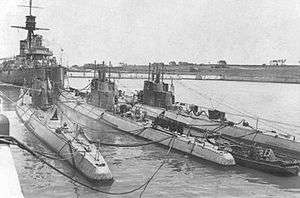Santa Fe-class submarine (1931)
The Santa Fe-class submarines were a class of three pre-World War II submarines, designed and built in Italy in 1928-1933, as part of an Argentine expansion plan for its navy. They were in service with the Argentine Navy from the early 1930s to the late 1950s. The class was named after Argentine provinces starting with “S”, as traditional in the Argentine Navy.[1]
 The 3 "Santa Fe"-class submarines in Mar del Plata, in the background mother ship ARA "General Belgrano", date unknown | |
| Class overview | |
|---|---|
| Name: | Santa Fe-class submarine |
| Builders: | Cantieri navali Tosi di Taranto, Taranto, Italy |
| Operators: |
|
| Built: | 1928-1958 |
| In service: | 1932-1960 |
| In commission: | 1933-1960 |
| Planned: | 3 |
| Completed: | 3 |
| Retired: | 3 |
| General characteristics | |
| Type: | submarine |
| Displacement: | 935 (surface) to 1,155 (submerged) tons |
| Length: | 64.24 m (210.8 ft) |
| Beam: | 6.68 m (21.9 ft) |
| Draft: | 5.05 m (16.6 ft) |
| Propulsion: | 2-shaft; surface: 2 × Tosi diesel engines @ 3,000 ihp (2,200 kW), 90 tons oil; submerged: 1 x electric motors @ 1,400 ihp (1,000 kW) |
| Speed: | surface: 17.5 knots (20.1 mph; 32.4 km/h); submerged: 8.5 knots (9.8 mph; 15.7 km/h) |
| Range: | 7100 nautical miles @ ?kn |
| Test depth: | 80 m (260 ft) |
| Complement: | 40 |
| Sensors and processing systems: | 2 periscopes |
| Armament: |
|
| Armour: | none |
| Notes: | Specifications from “Conway’s All the World’s Fighting Ships, 1947-1995” and “Histarmar” website. |
Design
Service history
Specifications
Ships in class
| Ship Name | Pennant Number | Other names | Builder | Laid down | Launched | Service entry | Decommissioning |
|---|---|---|---|---|---|---|---|
| Santa Fe | S-1 | none | Franco Tosi, Taranto | 1928 | 28 July 1931 | 1932 | 1956[n 1] |
| Santiago del Estero | S-2 | pennant to S-3 (later date, unconfirmed) | Franco Tosi, Taranto | 1928 | 28 March 1932 | 1933 | 1959[n 2] |
| Salta | S-3 | pennant to S-2 (later date, unconfirmed) | Franco Tosi, Taranto | 1928 | 17 January 1932 | 1933 | 1960[n 3] |
gollark: It's too stringy, unsafe (not in the memory-safety way), lacking useful constructs from any modern language ever (USABLE ARRAYS?!), and... well, that's it really.
gollark: systemd makes them unable to do stuff like have memory be writable and executable at once, gain extra capabilities, see most system folders and /home, and such.
gollark: And shell is an atrociously awful language in my opinion.
gollark: Well, many of my services have sandboxing applied now.
gollark: Much nicer than ineffable shell scripts.
See also
- List of ships of the Argentine Navy
- Italian submarines of World War II
- Submarine Force Command
Footnotes
- Scrapped by Dirección General de Fabricaciones Militares (date not confirmed).
- Sold to Roberto Aguirre and used as oil hulk at the Buenos Aires port.
- Sold to Aaron Gutman in 1961; final fate unconfirmed.
References
Notes
- Historia - Tradiciones - Nombres de buques Armada Argentina, sitio oficial (in Spanish) Official website of the Argentine Navy (accessed 2016-12-29)
Bibliography
- Gardiner, Robert (1996). Conway's All the World's Fighting Ships, 1947-1995. Annapolis, Maryland, USA: Naval Institute Press. p. 675. ISBN 978-155-75013-25.
- Arguindeguy, Pablo (1972). Apuntes sobre los buques de la Armada Argentina (1810-1970) (in Spanish). Buenos Aires, Argentina: Comando en Jefe de la Armada.
Further reading
- Burzio, Humberto (1960). Armada Nacional (in Spanish). Secretaria de Estado de Marina.
- Burzaco, Ricardo (1999). SUBMARINOS DE LA ARMADA ARGENTINA 1933 - 2000 (in Spanish). Buenos Aires, Argentina: Eugenio B. ISBN 9789879676417.
External links
- “Tarantinos” class submarines - Histarmar website (Historia y Arqueología Marítima – Submarinos Clase “Tarantinos”) (accessed 2016-12-30)
- “Santa Fe” submarine S1 - Histarmar website (Historia y Arqueología Marítima – Submarino “Santa Fe” S1) (accessed 2016-12-31)
- “Santiago del Estero” submarine S2 later S3 - Histarmar website (Historia y Arqueología Marítima – Submarino “Santiago del Estero” S2 luego S3) (accessed 2016-12-31)
- “Salta” submarine S3 later S2 - Histarmar website (Historia y Arqueología Marítima – Submarino “Salta” S3 luego S2) (accessed 2016-12-31)
| Wikimedia Commons has media related to Santa Fe class submarines. |
This article is issued from Wikipedia. The text is licensed under Creative Commons - Attribution - Sharealike. Additional terms may apply for the media files.